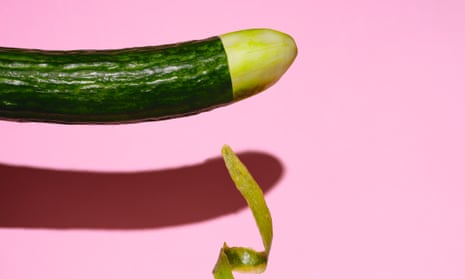The day before I had the chop, I visited the National Gallery in London to study a painting of the baby Jesus. Without wishing to get too CSI: Bethlehem about this, there is very little physical evidence to warrant the title The Circumcision. In this painting by someone from the workshop of Giovanni Bellini, the sumptuously bearded mohel, tasked with removing the foreskin, hides the operation from our view with his hand. Look as I might, I could see neither knife nor holy penis.
The day after my encounter with Jesus, I am due to have a centimetre of my foreskin removed for a condition called phimosis, which means tight foreskin. While phimosis is normal among male infants as the foreskin is attached to the glans in early development of the penis, in adults the condition is pathological. I have not been able to find out how many British males have been circumcised as adults, but my urologist told me it is not uncommon: during what he hilariously called “insertive sexual intercourse”, the foreskin retreats, causing tearing if it is non-retractable. Tearing didn’t happen in my case, but the attachment of foreskin to glans caused soreness and, without wishing to suggest this was a cosmetic procedure, looked wrong.

The condition can be treated with steroid creams, but my surgeon suggested that a few minutes in his operating theatre would do the trick. Having been treated under local anaesthetic four times last year for a detached retina, the prospect of having my crown jewels cut, stitched and cauterised didn’t terrify me quite as much as it would have done a few years ago.
A friend who had the same operation told me: “I’d been so embarrassed about my foreskin sticking to my knob that I became afraid to have sex. I didn’t know what to do, so I steeled myself to go to the GP. They were very helpful, telling me that there was a surgery and that it would cut off part of my foreskin and allow me to see my glans in all its unsheathed glory for the first time in ages.” And so it came to pass. My friend says his sex life has improved 100% since then.
In many ways, my experience was nothing like Jesus’s. My circumcision was elective. It took place not on a Galilean plinth but at a hospital in Hendon, north-west London. I am not eight days old but eligible for a free bus pass. Few of my countrymen have had their foreskins removed (in the UK, the latest figures indicate 20.7% of males, compared with, say, 71.2% in the US, 13.5% in India, 96.4% in Pakistan and just 1.3% of Brazilian men). Most importantly, I was operated on under general anaesthetic. Without those drugs, I would have done more than clutch my fists and look heavenwards – I would have run through Hendon’s streets screaming with my surgical gown flapping behind me until I was arrested.
After the operation, I reclined for a while on the bed in a private room (though the operation was on the NHS, it took place in a hospital so posh that the nurse showed me a menu before I was taken into theatre) and thought, deliriously, of the late Miles Kington’s droll Channel 4 documentary In Search of the Holy Foreskin. In the programme, he toured Italy trying in vain to find everybody’s Top 10 favourite holy relic, Jesus’s foreskin, which has been venerated for centuries as a religious icon. What happened to mine, I asked the nurse when she came to take away the tea tray. It was disposed of with the rest of the medical waste, she said. Shame: I imagined it in a glass case, the faithful abased before its majesty. Or worn on Saint Catherine’s ring finger following her mystical marriage to Christ. Or, as one 17th-century theologian maintained, rising from the Earth to find a new identity as a ring of Saturn.
My wife drove me home a couple of hours after the surgery. The anaesthetic was wearing off and every speed bump was a kick in what remained of the crown jewels. Back home, I reclined once more and Googled questions that troubled me. What, I wondered, is the foreskin for? It must serve some evolutionary function otherwise it would have withered, you’d think, on the proverbial vine. And why, historically, have so many cultures had it ceremonially removed from their baby boys?
Certainly, circumcision is a ceremony marking the covenant between God and Abraham but, as journalist Elon Gilad contended in the Israeli newspaper Haaretz, that covenant seems to be a later development. When ancient Semitic peoples became farmers, Gilad argued, they came to associate pruning with improved fertility. Indeed, Leviticus 19:23 links circumcision to this agricultural practice: “And when ye shall come into the land, and shall have planted all manner of trees for food, then ye shall count the fruit thereof as uncircumcised: three years shall it be as uncircumcised unto you: it shall not be eaten of.”
In Israel today, 91.7% of men (not all Jews, of course) are circumcised. For a proudly Jewish writer like Philip Roth, circumcision was a symbolic moment. “Quite convincingly, circumcision gives the lie to the womb-dream of life in the beautiful state of innocent prehistory, the appealing idyll of living ‘naturally’, unencumbered by man-made ritual,” as he put it in his novel The Counterlife.
There are other perspectives. For instance, Islamic scholar Dr Khalid Zaheer cites medical and religious reasons for infant male circumcision. “An uncircumcised person cannot, at times, keep himself clean after urinating. We have to keep ourselves mentally and physically clean five times a day to formally remember God in our prayers.”
In Britain, circumcision is unusual. In part, this is because of an influential and surprisingly fascinating 1949 paper called The Fate of the Foreskin by Douglas Gairdner in which the Cambridge paediatrician argued strongly against the view prevailing in America that boys are better off without foreskins. “As soon as it [the boy’s foreskin] becomes retractable, which will generally occur some time between nine months and three years, its toilet [ie cleaning] should be included in the routine of bathtime ... If such a procedure became customary the circumcision of children would become an uncommon operation.”
after newsletter promotion
By contrast, in the US male circumcision is so common that an uncircumcised male would stand out in the locker room. This is chiefly because of the strong medical case that removing the foreskin reduces risks of several infections and diseases. According to the American Academy of Paediatrics, the risk of urinary tract infections in uncircumcised boys under age two is about 1%; in circumcised boys, the risk decreases between threefold and tenfold. The risk of penile cancer is also apparently reduced by circumcision, though as the New York Times reported, penile cancer is so rare – at least in the US – that an estimated 300,000 newborns would have to be circumcised in order to prevent a single case. Circumcision has also been claimed to reduce the risk of some sexually transmitted infections, including genital herpes (reduced by 28%, according to one study).
I read these and many other reports and papers, fascinated, as I convalesced. So far, I have been fortunate: bandages and stitches fell away, pain was minimal and the prescribed gels did the trick of soothing my soreness. Others have not been so lucky. Terry Brazier, 70, made headlines in 2019 after going to Leicester Royal Infirmary for a bladder procedure and being mistakenly circumcised instead. Brazier was awarded £20,000 in compensation. Three years ago, under the headline “I’m scared of my penis”, a 21-year-old man named Curtis told the BBC that he developed post-traumatic stress disorder after his wound became infected following a partial circumcision aged seven.
I wince over the problems these men suffered, but prefer to look on the bright side. According to a 1988 survey, American women favoured the appearance of circumcised penises. Ninety per cent of women reported circumcised penises look better, 92% said they were cleaner and 85% said they were more pleasant to touch.

Disappointingly for me, Georganne Chapin, author of the forthcoming memoir This Penis Business: Circumcision in the US, is sceptical about these kind of claims. Chapin is founder and director of Intact America, which for the past 15 years has lobbied against baby boys being circumcised in the US. “Every single circumcision leaves a penis smaller and less sensitive than it was in its original state,” she says over a video call from Atlanta. “The foreskin is there for a man’s pleasure and the pleasure of his partner. It contains thousands of highly sensitive nerve endings that make sexual intercourse more enjoyable. It also protects the glans, or the head of the penis, from everyday chafing, drying out and losing sensitivity.” (Although a topic of continued debate, a number of studies have in fact shown circumcision has minimal effect on sensitivity.)
Chapin argues that there is a very simple reason for the difference in circumcision rates between the US and UK. “In Victorian times, circumcision was put forward as prevention for a huge range of diseases in the US and the UK. But now you have a national health service that doesn’t pay for unnecessary services, while the US has a health system whereby you can have anything if you can pay for it. Here, private insurance in a lot of cases covers circumcision. It’s outrageous that that is the case. In the US, it’s part of the business of medicine.”
Chapin’s memoir discloses that she first became aware of the practice aged 10 when her baby brother came home from hospital with bloody genitals after circumcision, and two days later following complications was returned to hospital for treatment to his urethra.
“Then people started speaking out about female genital cutting and I thought: ‘Well, we do that to boys – but why?’” When she gave birth to her son in 1980, she did not want him circumcised. “I wouldn’t have had him circumcised any more than I would have poked out one of his eyes. When he was 18 he thanked me.” Why – because he believed he had better sex? “Of course. He was obviously sexually active and enjoying his whole body. That’s why he thanked me.”
But surely she doesn’t oppose circumcision for medical reasons. “There are cases where it is medically necessary, but as far as I’m concerned, if you can give informed consent, that’s fine. Babies can’t.”
Surely female genital mutilation and male circumcision are different? “They’re both child genital cutting. For girls, genital cutting can range from pricking blood on some part of the genitals, the clitoris or the labia to infibulation [the ritual removal of the external female genitalia and the suturing of the vulva, practised in some east African states].”
This is a controversial view. For instance, anti-FGM campaigner Leyla Hussein rejects the parallel, writing on HuffPost that its purpose is “to control a woman’s sexuality. Full stop. FGM is done to prevent a woman from enjoying sex in order to keep her ‘pure’. Male circumcision is done for completely different reasons, including religious, aesthetic, hygienic … a circumcised male can still enjoy sex, and the practice is not done to decrease sexual pleasure. FGM is far more damaging to a woman’s sexuality than MGM is to a man’s.”
What, I ask Chapin, about millions of Muslims, Jews and others who for cultural and religious reasons were circumcised as boys in ritual practices going back millennia. Do you object to them? “I do object! There’s absolutely no reason for cutting normal, un-diseased body parts of a person who cannot give consent.”
Of 1.5m circumcisions done each year in the US, she reckons, only 25,000 are performed for religious reasons. The remainder, she argues, are done because the medical profession has convinced the American public that foreskins are not hygienic.
Although my experience wasn’t quite the kind of trauma described by Chapin, I can empathise with those who suffered the unkindest cut while, you’d imagine, they were still suffering PTSD from being born.
I call up an online version of The Circumcision and look again at the little chap’s tiny clenched fists and eyes raised heavenwards as if to say: “Cheers for this, Dad.” In many ways I’ve been much luckier, though I still have concerns. Perhaps I’ve made a mistake. Perhaps I should have tried the steroid creams. Maybe, if I’m concerned about diminished sensitivity in my penis (which I hadn’t been, until talking to Chapin), I should stretch what remains of my foreskin over my penis. Or buy Novoglan’s non-surgical phimosis treatment foreskin tissue expander kit (RRP £150), which promises results within weeks, even though the illustrations make it look as though I’d be putting a Vacu Vin over my penis. No matter. It could become a hobby.
